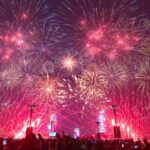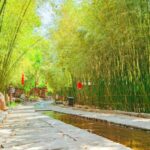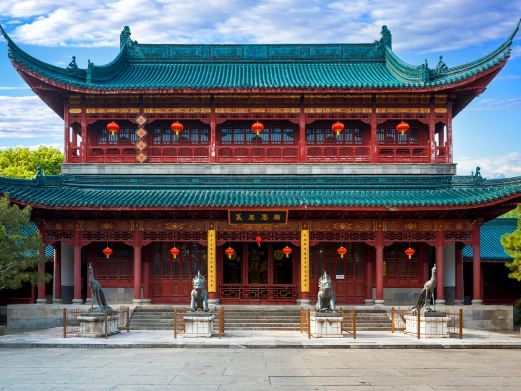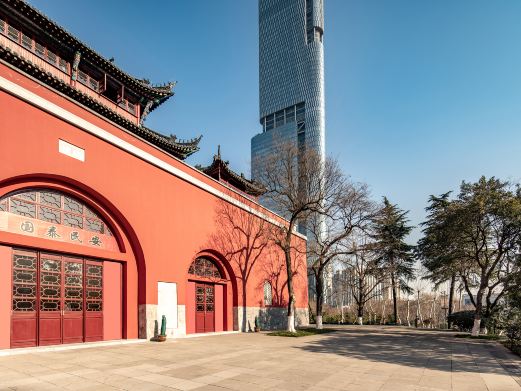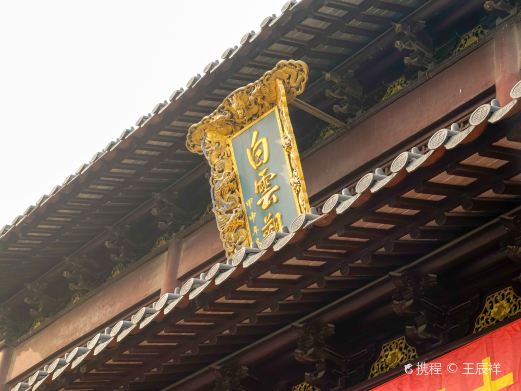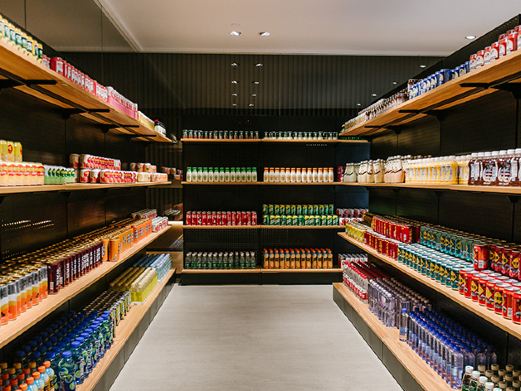The Shuanglong Scenic and Tourism Area, covering an area of 7.95 square kilometers, features natural attractions such as the Shuanglong Cave, Binghu Cave, Taoyuan Cave, Erxian Cave, Xiandong Cave, and Shuanglongxi Gorge, which display karst landforms and landscape scenery. It also includes sites for red education and traditional culture, such as the former site of Shuanglong Power Station inspected by leaders, Huangdaxian Ancestral Palace, and Zhizhi Temple. Additionally, it offers outdoor hiking, vacation leisure, and popular check-in spots like the Xiake Ancient Road, Lu’nv Lake, and Lianhua Viewing Platform.
Shuanglong Cave: Named for the two stalactite dragon heads hanging at the cave entrance, which are lifelike, the Shuanglong Cave is known as a ‘spectacle of water and stone’ and is one of the ‘Thirty-Six Cavern Heavens and Seventy-Two Blessed Lands’ in Taoism. The cave consists of an outer and inner cave; the outer cave covers an area of about 1200 square meters, capable of accommodating a thousand visitors, commonly referred to as ‘Dragon Hall’. The inner cave covers an area of about 2000 square meters, filled with peculiarly shaped stalactites, stalagmites, stone curtains, stone columns, and stone bells. To explore the cave, one must lie flat in a small boat, facing up and entering against the current, which is thrilling yet safe, making it a unique way to visit.
Binghu Cave: Located south of Shuanglong Cave, the cave’s sea entrance faces the sky, characterized by a small mouth, large belly, and long body, giving the feeling of entering a pot. The cave is named for its piercing cold air in summer. On the right side of the cave top, there is a waterfall with a drop of more than 20 meters, cascading down like a galaxy inverted, with a thunderous sound, misty spray, and extraordinary momentum, making it one of the largest cave waterfalls in the country. Binghu Cave is not only known for its silver waterfalls but also for its diverse stalactites. Looking up, there is a huge stalactite resembling a giant Buddha’s hand hanging next to the waterfall, adding to its grandeur.
Taoyuan Cave: It is said that Huang Chuping became an immortal in Jinhua Mountain, and the cave’s springs and waterfalls come from the Xiao Taoyuan where Huangdaxian ascended to immortality. Ancient people called it ‘a secluded paradise’, hence the name Taoyuan Cave. Taoyuan Cave has a unique structure and magnificent, ever-changing scenery, with main attractions including ‘Sky Dog Watching the Moon’, ‘Divine Ram Breaking the Wall’, ‘Buddha’s Hand Flower Corridor’, ‘Nine Dragons Playing with Water’, and ‘Rhinoceros Carrying Holy Fruit’. The cave is filled with stalactite accumulations, stone forests, and towering stone pillars, forming a unique underground natural scenery that can be described as a ‘secluded paradise’, leaving visitors in awe.
Er Xian Cave: Developed in the limestone strata of the Permian period, 280 million years ago, it is an underground river erosion and corrosion type multi-layered cave system. The cave consists of three layers of caves, two underground rivers, five corridors, and five large halls, with cave features that are breathtaking. Natural landscapes such as stone flowers, stalagmites, stalactites, stone curtains, and waterfalls are abundant and dazzling, especially the naturally formed grand canyon inside the cave and the crystal clear stone flowers formed by biological algae, which are rare among the cave landscapes in the country.
Xianpu Cave: Xianpu Cave is an underground river cave in Jinhua Mountain, offering a broad view and charming scenery, allowing visitors to overlook from a height and gaze into the distance.
The Shuanglong Scenic Area boasts two distinctive features of its karst cave clusters. First, there is a waterfall with a drop of 73 meters inside the cave, which is one of the largest single-stage drops in the world within karst caves, and was listed in the Guinness World Records in 1999. Second, the area is known for its adventure-centric activities, making it an ideal destination for young adventurers with a spirit of exploration.
Shuanglongxi Canyon: The Shuanglongxi Canyon, approximately 4 kilometers long, features an open valley bottom with an east-west width of about 800 meters, representing a typical gorge landform with deep ravines flanked by mountains. The canyon is lush with vegetation, well-preserved in its original ecological state, and offers a beautiful natural environment. Along the canyon, there are cultural nodes and landscape features such as sculptures of famous figures (Li Yu, Li Qingzhao, Li Bai, Xu Xiake, Huang Binhong, Yu Dafu, etc.), cliff inscriptions, and rest pavilions, making it both an ecological fitness corridor and a historical culture corridor.
Leaders’ Inspection of the Shuanglong Power Station Site: Originally constructed in May 1958, it was the crowning achievement among the eight cascade hydropower stations built by the Jinhua Regional and County Committees on Jinhua Mountain. On March 14, 1960, a leader visited the site by special train and highly praised the Jinhua people’s self-reliance and hard work in developing small hydropower. The Shuanglong Power Station thus gained national and global attention. In 2018, the power station underwent renovation and maintenance, significantly restoring its original appearance and setting as it was during the leader’s inspection.
Zhizhe Temple: Founded in the seventh year of the Liang Emperor Wu’s reign (AD 526), it was a royal courtyard built by Emperor Wu of Liang, Xiao Yan. It is a renowned Buddhist historical and cultural site within the tourist area, with nearly 1500 years of history, and represents the harmonious coexistence of Confucianism, Buddhism, and Taoism on Jinhua Mountain. The main hall of Zhizhe Temple covers an area of 4256 square meters, combining nine halls into one, making it one of the largest single-unit buildings in Buddhist monasteries nationwide.
Huang Daxian Ancestral Palace: Located by the Lu Nu Lake, the architecture faces north and is surrounded by mountains on three sides. The Ancestral Palace consists of 12 palace buildings and platforms, with a depth of over 800 meters across seven levels, covering an area of more than 5000 square meters. Huang Daxian Ancestral Palace is a traditional Taoist palace building in China, pursuing an artificial beauty of axial symmetry and uniformity.
Xiake Ancient Path: Xu Xiake, an outstanding geographer, traveler, and literary figure of the Ming Dynasty, visited Jinhua Mountain four times in his life. His research on karst landforms was a major scientific achievement, and the starting point was Jinhua Mountain’s Xiake Ancient Path, which was the official road from Luo Dian to Shuanglong in ancient times. To promote Xu Xiake’s patriotic spirit and dedication to science, the first phase of reconstruction from Bailu Xia to Yangjia Mountain, spanning 3 kilometers, has been completed. The path is flanked by mountains, with the sound of spring water, birdsong, and fragrance of flowers, offering a changing view with every step, and a refreshing experience.
Lu Nu Lake: At an altitude of nearly 600 meters, it is a rare alpine lake in Zhejiang Province. The lake surface is like a bright mirror embedded in the green mountains, with clear blue water reflecting the surrounding peaks like a painting.
The 3,000-meter lakeside walking path and hydrophilic plank road around Lunu Lake create a lakeside landscape belt, including areas such as the metasequoia forest plank road area, flower sea stone wave area, Juyan tribute tea industrial area, and waterfront sandy beach leisure area, making the characteristics of ‘fairy mountain, holy water, and secluded forest’ of this landscape more prominent. Around the lake, there are Huang Daxian cultural landscape nodes, which are divided into dynamic, static, elegant, leisure, and gathering functions. Natural ecology and human activities complement each other. Tourists can enjoy coolness and escape the heat here, stay for a short leisure time, experience health preservation, take a stroll around the lake, take wedding photos, go sightseeing on the lake, and experience Huang Daxian culture and Confucian culture. Lotus viewing platform: The viewing platform is adjacent to Yupingshan and Laohu Rock in the east, faces Yuanbaoshan in the south, is adjacent to Huwei Mountain in the west, and is backed by Lotus Holder. It is located in the wilderness with an altitude of 812 meters and has a wide view. Standing on the viewing platform, one can closely observe the mysterious water and holy stones and enjoy the charm of hundreds of miles in the distance. In spring, one can view the brilliant mountain flowers. In summer, one can appreciate the green mountains. In autumn, one can enjoy the beautiful red leaves. In winter, one can see the silver splendor of ten thousand trees. In addition, there are interesting scenes such as ‘viewing the sea of clouds after rain, viewing the lights at night; listening to the birdsong in spring and hearing the chirping in autumn’. Opening hours: Open all year round from 08:30 to 16:40. Preferential policies: Children: Free for those under 1.2 meters (inclusive) or under 6 years old (exclusive); discounted for children between 1.2 meters (exclusive) and 1.5 meters (inclusive) or minors between 6 years old (inclusive) and 18 years old (inclusive). Elderly: Free for those over 70 years old with senior citizen cards; discounted for those between 60 years old (inclusive) and 69 years old (inclusive) with valid identity documents. Disabled people: Free with disability certificates. Active-duty military personnel, veterans, and revolutionary disabled soldiers: Free with military officer certificates, veterans’ preferential treatment certificates, revolutionary disabled soldiers’ disability certificates, retired cadres’ retirement certificates, and pension and preferential treatment certificates. Blood donors: Free with blood donation honor certificates. Students: Free for full-time college students, postgraduates, and doctoral students (excluding self-taught, adult education, online enrollment, and continuing education categories) with student ID cards. Police: Free with police officer certificates. Firefighters: Free with firefighter certificates. Journalists: Free with press cards. Service facilities: Parking lot: [Tourist Center of Shuanglong Scenic Area, Luodian Town, Wucheng District, Jinhua City, Zhejiang Province]. Reference price: ¥10/time. Address: At the entrance of Erxian Cave in Shuanglong Cave Scenic Area (with signboards). Number of parking spaces: 1280. WIFI: Account: i-zhejiang. Password: Verified login. Coverage: Full coverage. Mobile phone charging: Charging power sockets are available at the tourist center and volunteer service station. Luggage storage: Reference price: Free. Address: Consultation desk on the second floor of the tourist center. Documents need to be provided and mobile phone numbers left. Items need to be retrieved in time. No deposit is required. Scenic area interpretation: The scenic area provides manual interpretation services.
Cost: For groups of fewer than 10 people (including 10 people), it is 100 yuan per group. For each additional person, an additional 10 yuan is added相应. The maximum cost is no more than 300 yuan per group. Transportation within the park: Reference price: In off-season, adult ticket is 30 yuan per person and child ticket is 15 yuan per person. In peak season, adult ticket is 40 yuan per person and child ticket is 20 yuan per person. During May Day and National Day holidays, adult ticket is 50 yuan per person and child ticket is 25 yuan per person. Address: 180 meters east of the intersection of Jianfeng Road and Zhizhe Street, Wucheng District, Jinhua City, Zhejiang Province. Toilets: There are multiple toilets in Shuanglong Scenic Area, which are located at the main entrance of the scenic area, near the tourist center, and around various scenic spots. There are eye-catching signs. Smoking areas: Location: Shuanglong Scenic Area has designated smoking areas at multiple locations. Tourists can only smoke in designated areas. Mother and baby room: Address: There is a mother and baby room inside the tourist center. Catering: There are many farmhouses and restaurants in the scenic area, with obvious signs. Alipay/WeChat payment is available. Convenience stores: There are multiple convenience stores in Shuanglong Scenic Area, located at the tourist center (50 meters to the left of Shuanglong Cave) and near various scenic spots. Alipay/WeChat payment is available.
Shuanglong Scenic and Tourism Area
The Shuanglong Scenic and Tourism Area, covering an area of 7.95 square kilometers, features natural[...]

